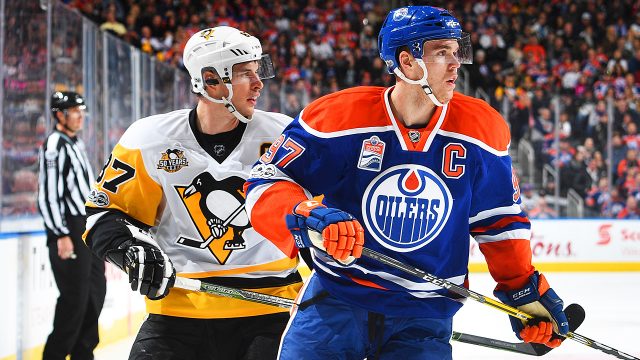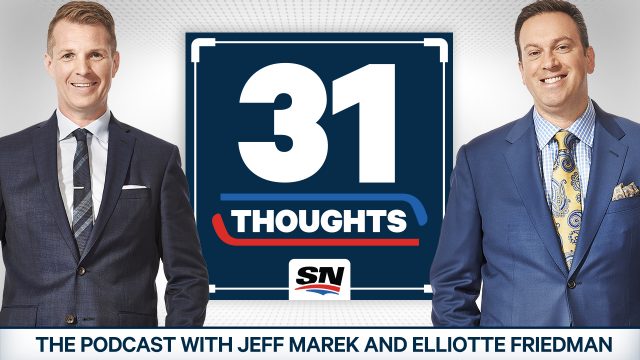
MONTREAL — We lived on a corner lot, in a semi-detached house on Normandy Drive — one of the widest and least travelled streets in the Town of Mount Royal, just a 15-minute car ride from the Montreal Forum. It was a street tailored for road hockey, with maple trees lining a perfectly paved, Y-shaped playing area, partitioned by a small park that served as a backstop for our net (if you missed, the ball didn’t travel as far through the grass as it did on the pavement).
That street was our arena, and as we fell further in love with hockey and the Montreal Canadiens, I took to fantasizing I was Mats Naslund, or Bobby Smith, or Guy Carbonneau, or Shayne Corson, or Brian Skrudland.
My twin brother, Kevin, was Patrick Roy and only Patrick Roy.
If you were a Quebec kid growing up in the mid-80s and early 90s, there was always someone in your game playing as Patrick Roy — dropping down into the butterfly, a windmill glove save away from dashing your dreams.
We were three-and-a-half years old in 1986, when Roy came on the scene as a gangly, pimply-faced, twitchy goaltender who carried the Canadiens to their 23rd Stanley Cup. We were too young to understand or appreciate what he had done, but just old enough to know his name and recognize it.
But by 1989, with the Canadiens falling just two wins shy of their 24th championship, Roy’s growing legend dominated our dinner discussions and filtered into our road hockey games. And by 1993, after he backstopped the team to 10 consecutive overtime wins and that elusive 24th Cup — capturing the Conn Smythe Trophy in the process — he had become a god to us.
You don’t trade a god. Or so we thought…
Sure, we knew it was possible — we were only seven years removed from Wayne Gretzky’s trade out of Edmonton — but we never saw the events of early December 1995 coming. And, keep in mind, we were 12 years old and unaware of any prior conflict between Roy and freshly appointed coach Mario Tremblay.
All we knew was that the Canadiens had come out of the gates that season with four consecutive losses and long-time general manager Serge Savard was suddenly fired and replaced by Rejean Houle, while Tremblay took over for Jacques Demers behind the bench.
The team desperately needed a spark and both men managed to provide it despite there being grave doubts they were qualified to do so. Tremblay and Houle had no experience prior to accepting their new roles, but they had managed to right the ship with wins in 12 of 19 games before Scotty Bowman’s red-hot Detroit Red Wings were scheduled to visit the Forum on Dec. 2.
I won’t pretend I remember every second of the game that precipitated Roy’s unceremonious departure from the Canadiens, but I do remember the feelings that bubbled to the surface as it unfolded. It felt like watching a car wreck in slow motion, and it was torturous. All of it.
There were the five goals pouring in through the first 20 minutes of terrible Canadiens play in front of Roy; the shock of seeing Roy take his net for the second; Roy looking over to the Montreal bench for a mercy pull after Mathieu Dandenault literally skated a puck into his net for Detroit’s seventh goal; it becoming a talking point on the broadcast that Tremblay was intentionally embarrassing Roy; Roy raising his arms after trapping a Sergei Fedorov slapshot from behind the blue line — essentially a dig at the fans who were mock-cheering him for stopping a puck; Roy finally coming out after being left in for nine goals; and Roy striding past Tremblay on the bench to put his stuff down before doubling back past the coach to tell team president Ronald Corey he had played his last game for the Canadiens.
And I’ll never forget that bizarre look on Roy’s face as he then took to his stool behind the team’s defence pairings, and the look of utter contempt for Roy that Tremblay was wearing. It was as cringeworthy as it gets.
It was incomprehensible and devastating all at once, particularly for Kevin.
“I distinctly remember being on a city bus the day after and discussing the whole thing with the driver,” my brother recalls. “The whole city was talking about it, and the team had suspended Roy and said they were going to trade him, and I just remember saying to the bus driver that they didn’t have to go this way, that they could salvage the situation.”
They didn’t.
It was inconceivable to us that Corey would choose Tremblay over Roy.
But we knew nothing about Corey and even less about Tremblay and his history as a hard-nosed, key contributor to five Cup-winning Canadiens teams, including the ’86 one that Roy led as a rookie.
Our arrows were pointed at Houle days later, when he announced that Roy and Mike Keane — a heart-and-soul type who was co-captain of the team at that point — had been traded to the Colorado Avalanche for wingers Martin Rucinsky and Andrei Kovalenko and goaltender Jocelyn Thibault. It was impossible to process that Roy had been disgraced and then discarded in haste, and that the Canadiens weren’t getting anyone back of note.
Not that Rucinsky was a bum — he turned out to be a solid player both for Montreal and in international competition with the Czech Republic — but he was arguably Colorado’s ninth- or 10th-best forward at the time.
Kovalenko wasn’t even on the radar. And Thibault was a highly touted prospect — the 10th overall pick in the 1993 draft — being dropped into the least favourable scenario.
Imagine a French Canadian player, with less than 60 games of NHL experience, coming home and having to take over for arguably the best goaltender in franchise history and a netminder widely considered the best in the world at that time. It’s as absurd as it sounds.
We’d have felt awful for him had our energy not been spent on hating Tremblay, Houle and Corey in no particular order. We despised the trade and the people who made it. We saw it as the worst one in the sport’s history, and we both still see it that way.
And it’s not just because a hero of ours was headed the other way for a paltry return.
“It wasn’t just that they traded Roy the player, the legend; it was how they gave up on what he represented and what that symbolized in terms of the direction of the organization,” says Kevin. “Patrick Roy was synonymous with winning, and you knew he was more dedicated to winning than anyone else in the organization. That was what you thought of when you thought of Patrick Roy: about how he would do anything to win.
“So when the team traded that away, when they gave the player away for pennies on the dollar, it was real foreshadowing of the direction they were heading in, which was anything but a good one. And it was painful.”
And that pain grew — not only in June of 1996, when Roy and the Avalanche were hoisting the first of two Cups they eventually won together while the Canadiens were golfing after a first-round loss to the New York Rangers, but for years that followed.
Canadiens celebrations of the past came and went, players were immortalized, and Roy remained an outcast. His estrangement from the organization was a source of pain for everyone who grew up idolizing him, and it was a constant reminder of what could’ve been but sadly wasn’t.
It took 13 years for this saga to end, with Corey’s successor, Pierre Boivin, announcing the Canadiens would retire Roy’s number 33 before a November game at the Bell Centre. It was a decision that came five years after Roy played his last NHL game and five years after the Avalanche had retired his number.
“Finally, I’m back home,” said Roy from the podium at his Canadiens jersey retirement ceremony on Nov. 22, 2008.
I was covering the game for Sirius/XM NHL Network and Kevin was in attendance with a friend. Watching that scene unfold brought us both back to Normandy Drive.






